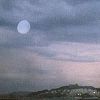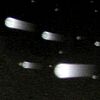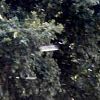In the 1990ies UFO groups and paranormal societies were flooded with photos of circular semi-transparent light forms, often with a bright ring around the edges and smaller concentric rings on the inside. Sometimes the images are made up of small dots of light placed in a more random way, making it look as if they are giant cells filled with a mixture of oil and water. Apparently these "orbs" - which is how they were dubbed - not only float around in people's backyards but manifest themselves inside our houses as well. Strange thing: none of the people who were there when the pictures were taken had ever seen the orbs with their own eyes. It was therefore speculated that the mystery objects either move at speeds too fast for the human eye to be perceived, or that they exist in a different plane than our own (there is doubt as to whether this would be a different wave length or a different time/space continuum). One of the most popular explanations is that the orbs are containers carrying the souls of the deceased, but paranoid UFO fanatics and conspirationalists think it more likely that the luminous balls are small probes from an alien civilisation or from our own government agencies who use them to spy on us.
The phenomenon rapidly assumed an important status and became a topic on web sites and forums. In the U.S. courses were offered in the techniques of orb photography and the International Ghost Hunters Society, who coined the term in 1994, even presented a "Floating Orb Award" for the most outstanding photograph.
There has rarely been a phenomenon that gave rise to so many wild and bizarre interpretations and at the same time is so easy to explain. Although the air around us appears most of the time to be clear and empty, it is in fact a floating junkyard filled with aerosols of all sorts (these can be minute particles of dust, skin, hairs, feathers, air-borne seeds, cobwebs, spots of moisture, snowflakes and tiny flying insects, to name but the most obvious). If any of these are caught by the flashlight of a camera at a moment they pass within a very short range of the front of the lens, such particles will be intensely illuminated. Because the camera focus is usually set to a greater distance, they will be extremely out of focus and rendered as balls of light. The concentric rings inside the images are "fresnel rings", an optical interference pattern caused when a ball-shaped wave first encounters an impenetrable surface with a round opening in it (the camera's aperture) and subsequently meets a flat surface not too far away from that opening (the sensitive surface of the camera).
Orbs only appear on film when the particles that cause them are close to the camera lens AND close to the flash (in the order of millimetres rather than centimetres). Only then the angle is right for a minuscule particle to reflect a big enough amount of light to show up as a bright ball. This explains why especially digital compact cameras that have a flash built in close to the lens, register orbs. Especially light-coloured particles and water drops can produce bright orbs.
Water drops can create other effects as well, both with digital and with traditional single-lens reflex cameras. Raindrops fall to the earth, so when they are captured on film one would expect a drop to appear as comet-like, with a bright spot below and a more diffuse tail trailing behind. Surprisingly, most cameras produce just the opposite image: a bright nucleus with a weaker tail extending downward, making the drop look like a light that shoots upward. This bizarre effect will only be noticeable with cameras that have a so-called "first curtain flash". A first curtain flash means that the flash goes off as soon as the shutter opens. When the shutter is still open and the flash is already out, an object moving in a certain direction will be illuminated by the flash during the first stages of its registered trajectory but will appear less bright towards the end of the exposure time, when it is illuminated only by the afterglow of the flash. The same goes for a falling drop of rain, which will be brightly lit by the light of the flash at the beginning of its fall, but leave a less bright trace during the last microseconds of the exposure, i.e. when the drop is closer to the ground.
Water drops that have settled on a camera lens or on a window pane can cause unsual effects as well, for instance when they distort the image of objects or lights behind them.






